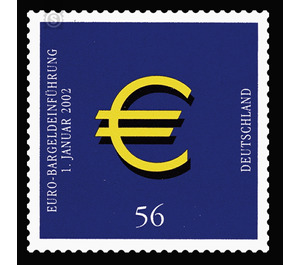Introduction of euro coins and notes (self-adhesive) - Germany / Federal Republic of Germany 2002 - 56 Euro Cent
Theme: Economy & Industry
| Country | Germany / Federal Republic of Germany |
| Issue Date | 2002 |
| Face Value | 56.00 |
| Printing Type | offset |
| Stamp Type | Postage stamp |
| Item Type | Stamp |
| Chronological Issue Number | 2109 |
| Chronological Chapter | GER-BRD |
| SID | 723967 |
| In 44 Wishlists | |
On 1 January 2002, the euro cash was introduced. In the largest cash exchange campaign of the modern era, new coins and notes came into circulation in twelve states simultaneously. In Germany alone, around 4.3 billion euro banknotes and 17 billion euro coins had to be made available. This makes the monetary union "understandable" for every citizen of the euro zone. With 300 million people, the world's second largest economic area after the United States. The comparability of prices in the euro zone revives the single market and increases competition. The European Central Bank under President Wim Duisenberg ensures a uniform monetary policy. Its primary objective is to ensure the stability of the currency. As "Guardian of the Euro" she is independent of instructions. The euro coins show identical value pages in all euro member states, but nationally different image sides. By contrast, euro banknotes are uniform in all Member States.


